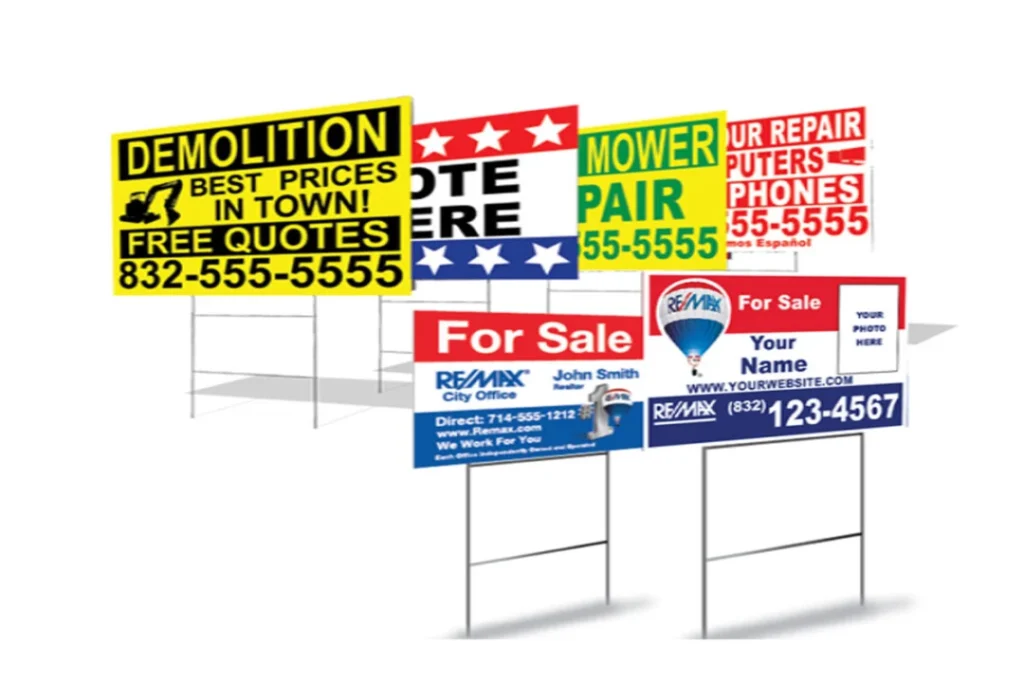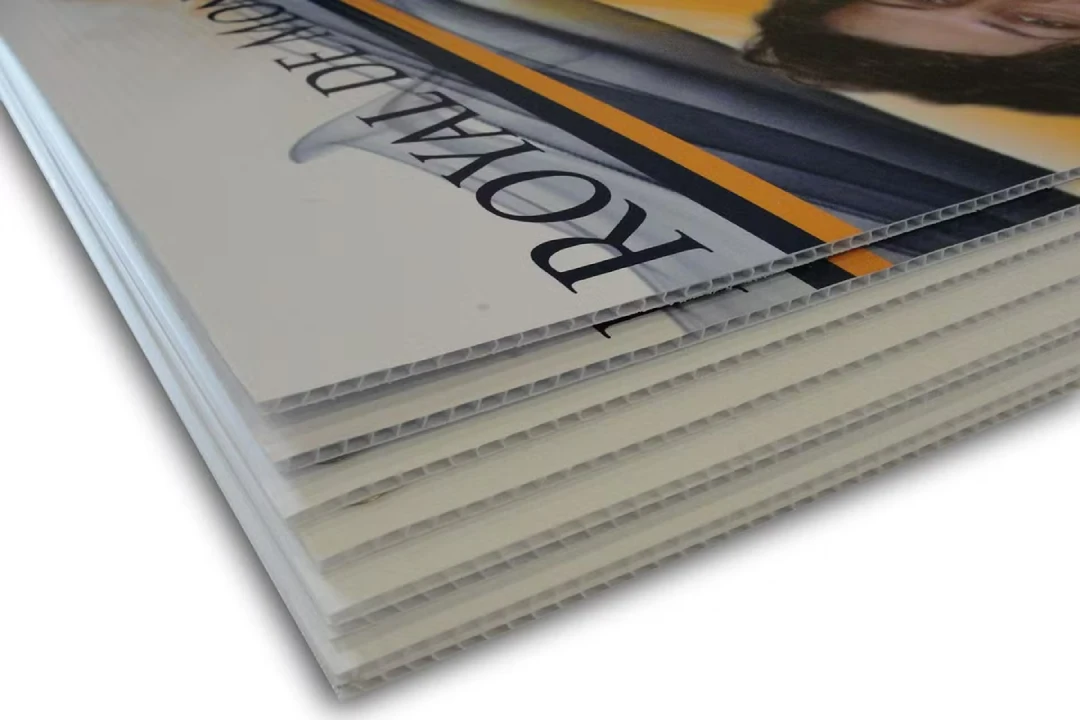Yard signs play a vital role in outdoor advertising, event promotion, and personal celebrations. Two commonly used materials for yard signs are Coroplast and vinyl. While both are popular choices, each material comes with distinct features, advantages, and limitations. Understanding the differences can help you make an informed decision that suits your specific needs.
What is Coroplast?
Coroplast, a brand name for corrugated plastic, is a lightweight yet durable material. Known for its water-resistant and UV-stable properties, Coroplast is often used for temporary signage due to its affordability and ease of use.
Features of Coroplast:
- Durability: Coroplast signs resist harsh weather conditions, making them ideal for short-term outdoor use.
- Lightweight: Easy to transport and install, Coroplast is a favorite for campaigns and events.
- Cost-Effective: It provides a budget-friendly option for those seeking temporary signage solutions.
What is Vinyl?
Vinyl, a versatile and robust material, is often chosen for its premium quality and longevity. Vinyl signs are frequently used for both indoor and outdoor applications, offering sharp, vibrant designs.
Features of Vinyl:
- Weather Resistance: Vinyl signs withstand rain, wind, and prolonged sun exposure.
- Customizable: Ideal for intricate designs, vinyl can handle detailed graphics with superior clarity.
- Longevity: Vinyl signs last longer than Coroplast, making them suitable for extended use.
Comparing Coroplast vs. Vinyl Yard Signs
The following table highlights the key differences between Coroplast and vinyl yard signs:
| Feature | Coroplast Signs | Vinyl Signs |
|---|---|---|
| Durability | Durable but ideal for short-term use | Long-lasting and weather-resistant |
| Cost | Budget-friendly | Slightly more expensive |
| Design Options | Limited detail capabilities | Suitable for intricate designs |
| Weight | Lightweight | Heavier than Coroplast |
| Application | Best for temporary signage | Best for long-term signage |
Advantages of Coroplast Signs
- Affordability: Coroplast is a budget-conscious choice, particularly for large-scale campaigns.
- Ease of Customization: These signs are compatible with screen printing, digital printing, and vinyl overlays.
- Sustainability: Coroplast is recyclable, contributing to environmentally conscious signage.
Ideal Uses for Coroplast:
- Political campaigns
- Real estate signage
- Event announcements
Advantages of Vinyl Signs
- Premium Finish: Vinyl offers a professional appearance with vibrant, sharp colors.
- Durability: These signs can endure harsh conditions, including prolonged UV exposure.
- Reusability: Vinyl signs are often reusable, making them a sustainable option.
Ideal Uses for Vinyl:
- Permanent outdoor signage
- Business branding
- Detailed artistic displays
Also Read: Top Benefits of Using Coroplast Signs for Your Business
Factors to Consider When Choosing
Purpose of the Sign
If you need temporary signage for an event or a campaign, Coroplast signs may be the better choice due to their affordability. However, if the sign is for long-term use or requires intricate design, vinyl signs would be a superior option.
Environmental Conditions
In areas with extreme weather, vinyl signs offer better resistance to UV rays and moisture. On the other hand, Coroplast can withstand moderate outdoor conditions effectively.
Budget Constraints
For those on a tight budget, Coroplast provides a cost-effective solution. However, the longevity of vinyl may justify its higher initial cost for permanent applications.
Practical Examples
Coroplast Signs in Action
- Political Campaigns: Widely used for promoting candidates during elections.
- Garage Sales: Temporary signage for quick and easy communication.
- Event Wayfinding: Directing attendees at fairs or exhibitions.
Vinyl Signs in Action
- Business Branding: Perfect for storefronts and business logos.
- Real Estate: High-quality property signs that last through various weather conditions.
- Art Installations: Used in creative displays requiring intricate details.

Coroplast and Vinyl: A Sustainability Perspective
Sustainability is increasingly critical in material selection. Coroplast is recyclable, reducing its environmental impact. Vinyl, though less recyclable, can be reused multiple times, making it a sustainable choice for applications requiring durability.
Conclusion
Choosing between Coroplast and vinyl yard signs ultimately depends on your specific requirements. Coroplast signs are ideal for temporary and cost-effective solutions, while vinyl signs are better suited for long-term, high-quality applications.
By understanding the features, advantages, and ideal use cases of each material, you can make an informed decision that aligns with your needs.
Investing in the right yard sign material ensures that your message stands out effectively, no matter the application.
FAQ about Comparing Coroplast vs. Vinyl Yard Signs
Q1: What is the main difference between Coroplast and vinyl yard signs?
A1: Coroplast signs are lightweight and corrugated, ideal for temporary use, while vinyl signs are more durable and suited for long-term outdoor applications.
Q2: Which is more cost-effective, Coroplast or vinyl yard signs?
A2: Coroplast signs are generally more affordable, making them ideal for short-term events, whereas vinyl signs are slightly pricier but last longer.
Q3: Are Coroplast yard signs weather-resistant?
A3: Yes, Coroplast yard signs are water-resistant and handle mild weather well, but they may not endure extreme conditions like vinyl signs.
Q4: Can Coroplast and vinyl yard signs be customized?
A4: Both materials support full customization, including vibrant graphics and text, making them versatile for any purpose.
Q5: Which yard sign is better for long-term outdoor use?
A5: Vinyl yard signs are better for long-term use due to their durability and resistance to fading and harsh weather.
Q6: Are Coroplast signs environmentally friendly?
A6: Coroplast signs are made from polypropylene, which is recyclable, but vinyl signs are less eco-friendly.
Q7: Can Coroplast signs be reused?
A7: Yes, Coroplast signs can be reused if stored properly, but they may wear out faster than vinyl signs with repeated use.



